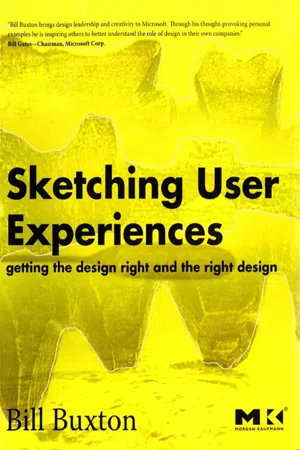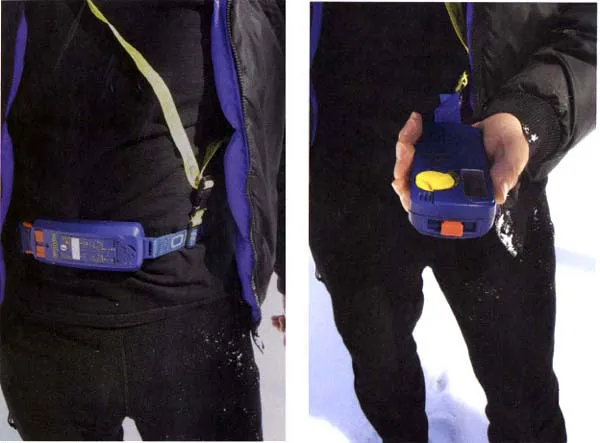
- 448 pages
- English
- ePUB (mobile friendly)
- Available on iOS & Android
Sketching User Experiences: Getting the Design Right and the Right Design
About this book
Sketching User Experiences approaches design and design thinking as something distinct that needs to be better understood—by both designers and the people with whom they need to work— in order to achieve success with new products and systems. So while the focus is on design, the approach is holistic. Hence, the book speaks to designers, usability specialists, the HCI community, product managers, and business executives. There is an emphasis on balancing the back-end concern with usability and engineering excellence (getting the design right) with an up-front investment in sketching and ideation (getting the right design). Overall, the objective is to build the notion of informed design: molding emerging technology into a form that serves our society and reflects its values.Grounded in both practice and scientific research, Bill Buxton's engaging work aims to spark the imagination while encouraging the use of new techniques, breathing new life into user experience design.- Covers sketching and early prototyping design methods suitable for dynamic product capabilities: cell phones that communicate with each other and other embedded systems, "smart" appliances, and things you only imagine in your dreams- Thorough coverage of the design sketching method which helps easily build experience prototypes—without the effort of engineering prototypes which are difficult to abandon- Reaches out to a range of designers, including user interface designers, industrial designers, software engineers, usability engineers, product managers, and others- Full of case studies, examples, exercises, and projects, and access to video clips that demonstrate the principles and methods
Frequently asked questions
- Essential is ideal for learners and professionals who enjoy exploring a wide range of subjects. Access the Essential Library with 800,000+ trusted titles and best-sellers across business, personal growth, and the humanities. Includes unlimited reading time and Standard Read Aloud voice.
- Complete: Perfect for advanced learners and researchers needing full, unrestricted access. Unlock 1.4M+ books across hundreds of subjects, including academic and specialized titles. The Complete Plan also includes advanced features like Premium Read Aloud and Research Assistant.
Please note we cannot support devices running on iOS 13 and Android 7 or earlier. Learn more about using the app.
Information

When traveling in terrain where there is avalanche risk, you spread out so that if there is an avalanche, you minimize the number of people caught in it. Someone always watches from a safe position (in this case it is the photographer) in order to spot where people are, in the event of a problem.

A transceiver is worn under your outer layer of clothing in order to minimize the risk of it being torn off by the force of an avalanche. The harness is a fundamental part of the design. The device works in one of two modes: transmit or receive. The default is that they are always in transmit mode. That is, normally, all of them should be transmitting a signal that can be picked up as an audible “ping” by a receiver. You want this as a default if you are buried, because the last thing that you want when caught by an avalanche is to be fumbling around with your transceiver. Snapping the waist strap into the device, which you have to do to wear it (left photo), automatically sets the device in the correct mode. That same connector has a fast-release mechanism. If someone is buried, the survivors undo the snap, and they are automatically in receive or search mode (right photo). Note that the device still is secured to the wearer by the yellow strap, in the event that the rescuers are hit by a secondary avalanche. All controls of the transceiver can be operated while wearing gloves (although I am not doing so in these photos).

The probe is like a long thin tent pole. It is light, and collapses for easy portability (left photo). It has a cable running through the centre of the poles that enables it to be assembled very quickly. When assembled (right photo), it is pushed down into the avalanche debris, enabling the rescuer to probe for the victim.

An avalanche shovel appears to be just a conventional shovel. However, it has a few conflicting constraints on its design. First, it must be compact and light, since you need to carry it in your pack. On the other hand, it needs to have a blade strong enough to penetrate the very hard consolidated snow encountered in avalanche debris, and be large enough to let you dig quickly and efficiently.
What Saved Saul?
Table of contents
- Cover
- Title Page
- Copyright
- Dedication
- Preface
- Acknowledgements
- Author’s Note
- Table of Contents
- Part I: Design as Dreamcatcher
- Part II: Stories of Methods and Madness
- References and Bibliography
- Index